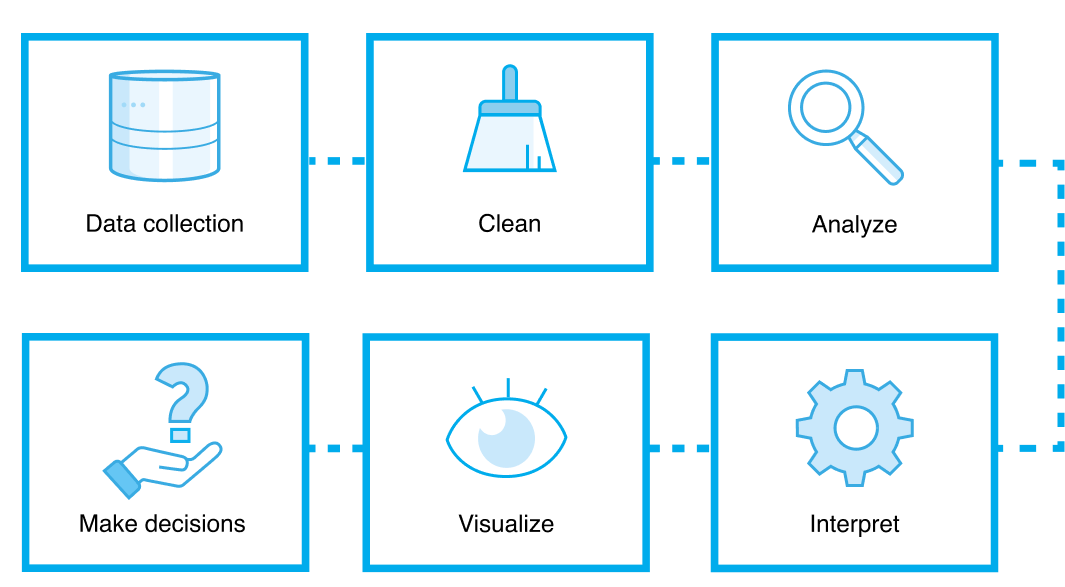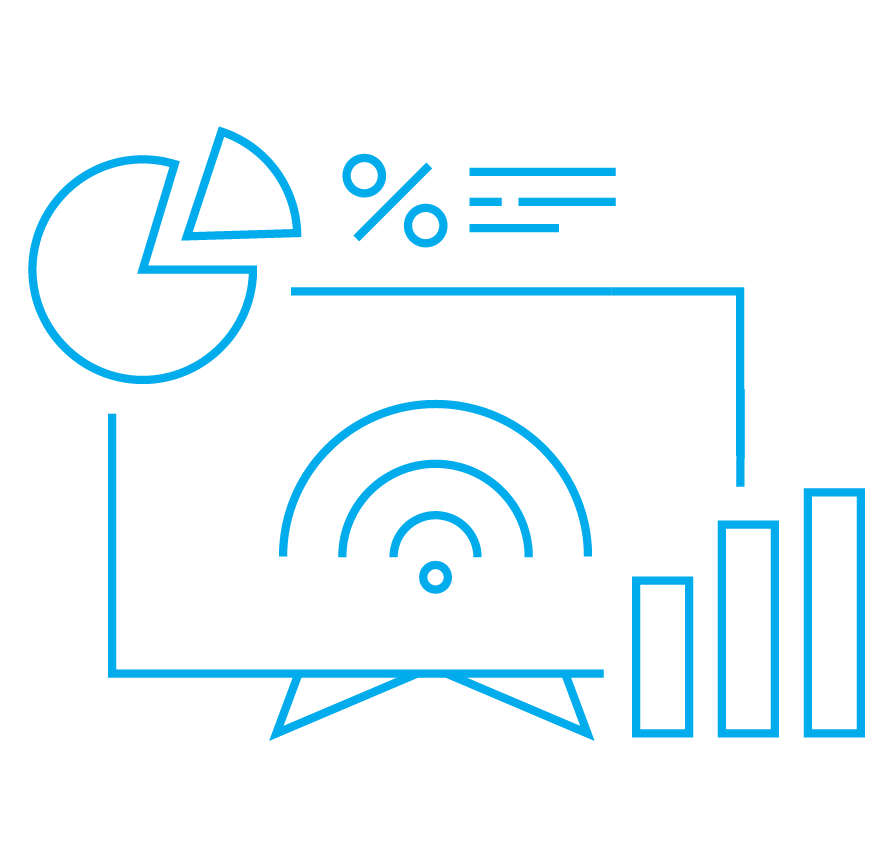- What is data analysis?
- What are the types of data analysis?
- What are the top data analysis techniques?
- What is the process of data analysis?
- What are the challenges of data analysis?
- What are the benefits of data analysis?
- What is the future of data analysis?
- Conclusion
Data is the new oil and the most valuable asset in the 21st century. Data is used in every industry, from marketing, finance to retail. It is used to improve efficiency, make better decisions, and drive innovation. Analyzing data in different configurations, methods and techniques allows us to get even more specific insights that optimize various business processes which have a significant impact on companies growth.
This article explores the importance of data analysis, the process involved, the benefits it offers, the challenges it presents, and the future trends shaping its evolution.
What is data analysis?
Data analysis is the process of collecting, cleaning, analyzing, and interpreting data to gain insights that can be used to make better decisions. It is a broad field that includes a variety of techniques and methods.
Data analysis is important because it can help businesses make better decisions, improve efficiency, and uncover new insights.

What are the types of data analysis?
Data analysis is a multidisciplinary field that employs a wide range of analysis techniques, including math, statistics, and computer science. It is broken down into four basic types:
Descriptive analysis describes what has happened in the past. It uses historical data to identify trends and patterns.
Questions supporting the descriptive analysis:
- What are the trends in stock market prices?
- What are the customer demographics for our products/ services?
- What are the top reasons for customer churn?
Diagnostic analytics identifies the root causes of problems. It uses historical data to identify trends and patterns, and then uses that information to understand why those trends and patterns are happening.
Questions supporting diagnostic analysis
- Why did our stock market prices decline last quarter?
- Why are our product/service customers churning at a higher rate than last year?
- What are the root causes of our customer complaints?
Predictive analytics predicts what will happen in the future. It uses historical data to build models that can predict future trends and patterns.
Questions supporting predictive analysis:
- What will the stock market do next quarter?
- What is the likelihood that a customer will step back from getting the product/service?
- What is the risk of a cyberattack on our bank?
Prescriptive analytics recommends actions to take. It uses historical data, predictive models, and business rules to recommend the best course of action.
Questions supporting prescriptive analysis:
- What investment strategies should we recommend to our clients?
- What pricing changes should we make to our products/services?
- What security measures should we implement to protect our bank from cyberattacks?
What are the top data analysis techniques?
There are several data analysis techniques that data analysis use to process data and extract valuable information. Some of the most popular are listed below:
Regression analysis is used to analyze the relationship between dependent variables and determine how a change in one variable may affect the change in another.
Factor analysis reduces a large dataset to a smaller set of factors and groups variables that are correlated with each other to identify hidden trends in data that would not be obvious otherwise.
Cohort analysis groups data into similar sets based on shared characteristics, such as customer demographics to allow data analysts to drill down into the data and identify trends and patterns that may not be visible when the data is analyzed as a whole.
Monte Carlo simulations use repeated random sampling to model the probability of different outcomes. This makes them a powerful tool for risk mitigation and loss prevention, as they can be used to identify and assess the likelihood of different risks.The technique is used to forecast future outcomes, as they can incorporate multiple values and variables into the model.
Time series analysis tracks data over time and identifies patterns in the data to predict future values of the data, or to identify cyclical trends. It is often used in finance to predict stock prices or to forecast economic growth.
What is the process of data analysis?
The process can be broken down into the following steps:
- Define the problem or question – determine the purpose of collecting and analyzing the data for.
- Collect the data – define the methods such as surveys, interviews, data mining, partnerships and reliability of data sources that are going to be used.
- Clean the data – ensure that the collected data is accurate and complete which means removing duplicate records, correcting errors, and filling in missing data.
- Analyze the data – apply various analysis methods depending on the data type and the expected result, get some support from machine learning algorithms and AI tools.
- Interpret the results – draw conclusions and insights from organized data reports, dashboards, and visualizations.
- Act on the results – prepare a strategy plan that will help develop and implement appropriate actions to boost business objectives, increase ROI, and other operational processes.
What are the challenges of data analysis?
The process of data analysis is an iterative process, which means that you may need to go back and forth between the steps as you gain more insights into your data. The process can also be complex and time-consuming, and challenging for a number of reasons such as:
- Data quality – only good quality data should be used for data analysis. If the data is not accurate or reliable, the insights that are gained from the data will be insufficient or inaccurate.
- Data volume – the amount of data that is available is growing exponentially which can make it difficult to collect, store, and analyze it.
- Data complexity – data can be difficult to understand, which can make it challenging to identify patterns and trends.
- Data privacy – the process of data analysis often involves the collection and analysis of personal data. This data needs to be protected to ensure the user’s privacy.
- Data security – data analysis often involves the use of sensitive data that should be protected from unauthorized access and misuse.
Skills and expertise – data analysis requires specialized skills and expertise which can make it difficult for businesses to find qualified data analysts.
Despite these challenges, data analysis is a valuable tool that can be used to gain insights and make better decisions. By understanding the challenges of data analysis, businesses can be better prepared to overcome them and reap the benefits of data analysis.
Here are some tips for overcoming the challenges of data analysis:
- Invest in data quality: Don’t save on data quality, make sure that data is reliable, privacy-safe and accurate to be able to gain valuable insights.
- Use the right tools: There are a number of tools available on the market, make sure to test out different ones before choosing the right one.
- Cooperate with qualified data analysts: Work only with qualified specialists to ensure that the data analysis is done properly and you get most out of it.
- Be patient: Data analysis can be a complex process. Be patient and don’t expect to get results overnight. With time and effort, you will be able to overcome the challenges of data analysis and gain valuable insights from your data.
What are the benefits of data analysis?
Data analysis can be a powerful tool for big organizations, small businesses and individuals especially in the following areas:
- Segment customer data – allows to organize customers data into groups based on their demographics, interests, and purchase behavior. Customer segmentation empowers marketers to target marketing campaigns at specific customers to achieve a given marketing or advertising goal.
- Improve decision-making – helps businesses make better decisions by providing them with insights into their customers, markets, and operations, e.i., identify the demand for sale, customers interested in specific products and services, or effectiveness of marketing and advertising campaigns.
- Increase efficiency – identifies areas where businesses can save time and money, e.g. data analysis can be used to optimize supply chains, reduce costs, and improve customer service.
- Gain new insights – uncovers new insights that they would not have been able to see without data analysis, e.g., data analysis can be used to identify new market opportunities, develop new products, and improve customer satisfaction.
- Reduce risk – minimizes risks by identifying potential problems before they occur, e.g., helps investors to act on data signals, mitigate the risks from the market and make proper decisions without impacting their assets or wallet.
- Improve compliance: provides insights to ensure that the relevant regulations are met. For instance, data analysis can be used to track customer data, identify potential fraud, and ensure that businesses are not discriminating against customers.
What is the future of data analysis?
The future of data analysis is optimistic, as the amount of available data continues to grow and so will the demand for collecting, cleaning, and interpreting data to gain insights and make better decisions.
In addition, the rise of artificial intelligence (AI) is also having a major impact on the field of data analysis. AI is being used to automate many of the tasks that were once done by data analysts, such as data cleaning and data mining. This is freeing up data analysts to focus on more strategic tasks, such as developing new insights and making recommendations.
As a result of these trends, the demand for data analysts with strong skills in AI is expected to grow significantly in the coming years. Data analysts who are able to use AI to their advantage will be in high demand on the market.
The rise of big data
Big data describes the massive amounts of data that is being generated every day. This data comes from a variety of sources such as:

The growth of big data is having a major impact on the way businesses and organizations operate. Big data can be used to gain insights into customer behavior, identify trends, and make better decisions.
However, big data can also be challenging to manage. It is important to have the right tools and skills in place to collect, store, and analyze big data, especially in the era of rising privacy concerns.
The impact of artificial intelligence
Artificial intelligence (AI) has revolutionized the field of data analysis, providing organizations with powerful tools to extract valuable insights from vast amounts of data. By automating tasks and utilizing machine learning algorithms, AI enables data analysts to focus on more strategic activities, like developing new insights and making informed recommendations.
The impact of AI on data analysis goes beyond processing capabilities. Machine learning algorithms can analyze historical data and identify patterns or trends that may not be easily visible to humans. This ability to uncover hidden insights helps businesses improve their operations and make data-driven decisions. Additionally, AI can analyze large data sets and learn from them, enabling organizations to make accurate predictions and optimize their decision-making processes.
AI and data analysis is colloquially considered to be “data on steroids” as when the two combined, the possibilities are endless. These technologies can be used to solve complex problems, help to make better decisions and improve human lives in a variety of ways.
Conclusion
Data analysis plays a vital role in modern business strategies, enabling organizations to unlock valuable insights from their data. By leveraging data analysis, businesses can make informed decisions, improve operational efficiency, and gain new insights that drive growth.
However, data analysis also presents challenges that need to be addressed, such as ensuring data quality, privacy, and security. As the field continues to evolve, the rise of big data and the impact of artificial intelligence will shape the future of data analysis. Embracing data analysis is crucial for businesses to stay competitive and thrive in the data-driven era.



